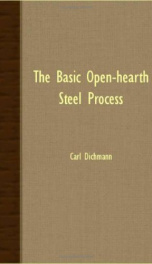the basic open hearth steel process

AUTHORS PREFACE DURING more than twenty years practical experience in open-hearth furnace management, I have frequently been faced with problems to which I was unable to find satisfactory solutions. A pause in such practical activity has enabled me to investigate these questions as a whole, and in this connec- tion I have taken advantage of all available literature on the subject which was at my disposal. The gaps remaining I have endeavoured to fill in to the best of my ability. This was the origin of my book, and in now giving it to the public, I do so on the plea that the literature relating to the open-hearth process is very meagre, in spite of the daily increasing importance of the process, and because I hope to enlist further workers in clearing up the abstruse problems involved. My guiding principle has been to ascertain the conditions which admitted of the complete utilisation of all raw materials in the best possible way. I have devoted special attention to the quantitative side of the subject, since procedure can only be completely known or controlled provided the effect of all determining factors can be quantitatively estimated. Naturally, in consequence of this, the necessity arose of making numerous calculations, such as could be carried out by the most elementary means at my disposal. In the course of my experience, I have felt the want of knowledge of the conditions governing the complete utilisation of fuel, and hence I devoted myself initially to the theory of gas producer working. The results arrived at appeared to me worthy of attention, although I was not so placed all my conclusions by experiments of my own. as to test The details of the calculations may appear, many of them, too extended and elementary nevertheless, I have given them in full in order to enahle one to check ones position should ones recollection fail, as might easily occur owing to so many values coming into consideration. All formulae arrived at are, moreover in so far as they have general validity, assembled in the Appendix, so that one is not obliged to seek them in the text. My papers published in Stahl und Eisen in 1905, on working molten pig iron in basic lined open-hearth furnaces, have served as a basis, which I have elaborated. In so doing, it appeared to me necessary to make certain allowances in the calculations of the amount of iron peroxide required for the removal of the reducing agents, and to take into consideration those amounts of ferrous oxide which remain in the slag, and which must be produced owing to the action of the individual reducing agents. As a consequence, the figures for the iron peroxide required for eliminating silicon have been increased, but for carbon decreased whilst conversely the growth of charge due to silicon appears less, and that due to carbon appears larger than in the papers mentioned. I am largely indebted to two instructive books, the first part of Leitfadens zur Eisenhuttekunde, i.e., Feuerungs- kunde, by Th. Beckert, which by its references and its tables of the values of specific heats of gases temperatures rendered it possible at various for me to calculate the temperatures of reaction and Campbells Manufacture of Iron and Steel, which suggested many new points of view. To these gentlemen, as well as many others whose names are mentioned in the text, I tender my most grateful thanks. EIGA, November, 1909, Signed CAUL DICHMANN, TRANSLATORS PREFACE SOON after the publication of Mr. Dichmanns treatise in Germany, one of my most intimate and able friends, who is engaged in one of the largest Continental steel works, sent me a copy...
Info about the book
Author:
Series:
Unknown
ASIN:
B008LE8BAI
Rating:
4/5 (3)Your rating:
0/5
Languge:
English
Users who have this book
Users who want this book
What readers are saying
What do you think? Write your own comment on this book!
write a commentif you like the basic open hearth steel process try:
Other books by this author
Do you want to read a book that interests you? It’s EASY!
Create an account and send a request for reading to other users on the Webpage of the book!

